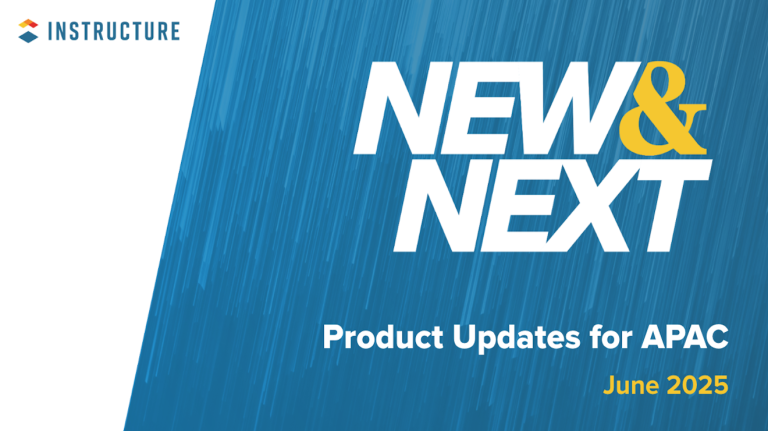Rethinking the LMS for in-person learning: Cost-saving and revenue-raising tips from higher education institutions
In brief:
- Savvy higher education institutions in the Asia-Pacific region are finding their learning management system (LMS) is essential for their day-to-day activities.
- It provides value through consistent experience across all students’ subjects, consolidation, and quality control for university administration, and equitable access.
- Institutions are saving costs by identifying and cancelling under-used or duplicated apps, instead using free or economical options they integrate into their LMS.
- Some institutions have saved time and trimmed training budgets. How? They’ve offered users support through pop-up information, videos, and searchable information within the LMS.
"Higher Education institutions are realising an LMS isn't just for online learning during lockdowns. An LMS provides value in three key areas: consistent student experience across all their subjects, greater equitable access, and, for university administration, tools to consolidate and [provide] quality control for university administration."
In the face of inflation and the return to in-person learning, higher education (HE) institutions across the Asia-Pacific region (APAC) are finding ways to cut costs and maximise their return on investment.
One of the ways they’ve been doing this is by leveraging their learning management system (LMS) to:
- Improve the quality of teaching and learning
- Ensure a consistent student experience
- Make learning more accessible
- Structure their rollout of training for users
- Help LMS administrators consolidate data insights across the platform
- Allow users to repurpose content, and
- Earn extra revenue by offering non-traditional short courses or certifications.
For HE institutions’ day-to-day business, an LMS is now essential. That was a key finding of a CanvasConnect event held in the Philippines recently.
Greg Faller, Manager APAC Solutions Engineering at Instructure, said: “Higher education institutions are realising an LMS isn’t just for online learning during lockdowns. An LMS provides value in three key areas: consistent student experience across all their subjects, greater equitable access, and, for university administration, consolidation and ensuring quality control.
“We’ve also seen a massive growth in feature sets available in the LMS that help boost efficiencies in teaching and learning. Some of those are ideal for non-traditional learners who want an additional way to access the classroom.”
The popularity of online education platforms has confirmed the Asian Development Bank’s 2021 prediction their use would continue post-COVID-19 and improve the following:
- The efficiency of education delivery
- The quality of individual learning, and
- The scope to become universally accessible.
Seamless student experience
However, challenges remain. At the CanvasConnect event attendees heard that students at a U.S. university had complained about their ‘fragmented experience’ of using an LMS to support face-to-face classes. Part of the problem was their educators’ varied skills gaps in implementing the technology.
The university leadership knew it needed to encourage its people to use the platform more consistently. It lifted student satisfaction after:
- Setting small steps for academics to harness the LMS across the institution, starting with assignments, then quizzes, then uploading the syllabus
- Improving support and training for all users, and
- Creating a continuous feedback loop to address issues more swiftly.
The university maximised their LMS by ensuring everyone who teaches at their institution has access to the same training, edtech resources, student support, and blueprints for course content. An LMS is built for sharing. Research shows that more than eight in 10 office workers say they waste time searching for documents throughout their workday. Finding the right content can also be an issue for learners.
Faller said: "Every student, whatever their accessibility needs are, will have equal access to all course materials on a robust LMS anytime and anywhere."
Flexibility of learning has become an expectation, not a “nice to have”. Students like to check their LMS to see their grades, receive feedback, and communicate with their peers and instructors.
Even face-to-face exams can run through an LMS. Just use a proctoring tool to authenticate those taking the exam, as the University of Melbourne did. Tap into the power of Canvas quizzing tools to automatically grade test responses, slashing administration time substantially.
Barriers to accessibility
However, there’s a huge divide in education accessibility and infrastructure in the Asia-Pacific region, finds Statista.
Access to higher education can be an issue in areas of unreliable internet connectivity, or where students lack their own computer for studying, instead sharing one with several family members. There are workarounds, though. For example, at a large Philippines University, Our Lady of Fatima University, 90% of students access their institution’s Canvas LMS via their mobile phones. That institution also negotiated with an internet provider for discounted data rates for their students. As well, students can download modules and work offline later.
Despite the chasm of poor connectivity, the Asia-Pacific region will more than double its investment in e-learning, such as through learning management systems. According to the Asia Pacific E-Learning Market Forecast to 2028 report, e-learning in the region will grow from almost US$56 billion to about US$114 billion in the six years to 2028. E-learning covers online, LMS, mobile, and other delivery modes, and the report spans K-12, HE, and corporate sectors.
Ensuring your ROI
With the region increasing its investment in edtech, higher education institutions should check they’re using their LMS to its full capacity. Key drivers include assessing usage, being nimble with training, checking for duplicated software/tools, and leveraging content for extra revenue.
Leadership can use the Admin Analytics feature set for near-real-time visualisations. They’ll show how well (or not) staff and students are using the platform and integrations, such as Microsoft Teams, and various external tools, across faculties, campuses or across their institution. They can then toggle onto the Impact tool to roll out actions, such as nudges, and offers of extra support, for example, that encourage adoption.
But those nudges need not involve live training sessions. One institution reduced its training costs by guiding first-time Canvas users with pop-up screens of information and embedded videos. As users explore the platform further, they’ll see different popups for training in context. The institution also supplemented this with in-house built automated messaging on their LMS, and created a library of screen-capture videos addressing FAQs.
Another way to boost ROI is to identify online tools that are under used or redundant across their organisation, said Faller.
“Are those tools still meeting the need for which you originally purchased them? Because Canvas is constantly adding functionality to our platform, consider if there’s an opportunity to consolidate some of those licences.”
And, instead of storing video or audio recordings in external accounts such as Zoom, opt to automatically transfer them into your institution’s Canvas Studio video library to save costs. At one institution, 95% of staff used Canvas Studio without any training.
Rather than just see their LMS as a cost, savvy HE institutions are leveraging it to generate revenue. That was a prompt from another speaker at the CanvasConnect event, Ramzy Alamundi, the Customer Success Manager for Instructure’s Singapore office.
“Most of the conversations I’ve been having with universities are about how they can repurpose content for non-traditional short courses, such as for professional development, even micro credentialling for people outside of your institution. We can support these moves through our Canvas Credentials tool and through [Canvas] Catalog.”
Alamundi suggested institutions should check-in with their Customer Success Manager for updates about Canvas advancements, including for artificial intelligence functionalities.
“We’re here to help you evaluate how your account is being used and make sure you’ve got the right features and functions enabled. You can integrate many other tools into your digital ecosystem for a really effective student experience and to support staff retention.
“Remember the free online treasure trove of best practices: the dynamic Canvas Community.”
For more tips to boost your Canvas ROI, watch the full CanvasConnect presentation recording from the Philippines.
Related Content
 new_and_next_apac_june_2025.png
new_and_next_apac_june_2025.pngBlogs
 meet-canvas-apac-team-christopher.png
meet-canvas-apac-team-christopher.pngBlogs
 philippines_ched_cmo.png
philippines_ched_cmo.pngBlogs